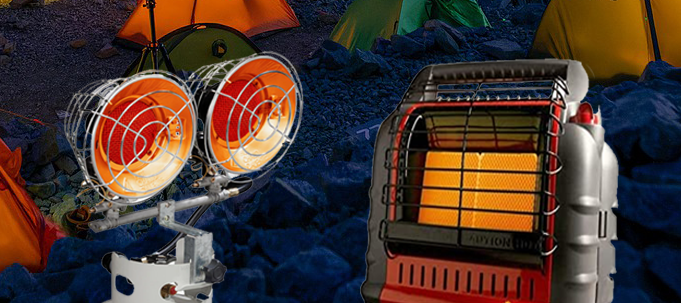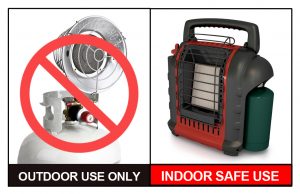
Know the difference between indoor-safe and outdoor only propane heaters
Portable propane heaters have become a handy resource for taking the chill out of cool nights for campers, RV’ers and hunters. You’ll also find them as a temporary heat source for a wide variety of other uses for heating chilly workspaces, garages, sheds and other ventilated spaces where electric power is not available. They are also a reliable temporary heat source for power outages.
There are a number various sizes and styles of portable heaters that use propane fuel to provide heat.
Two main categories of portable propane heaters include those that use small 1lb. propane cylinders
that attach to the heater and larger heaters that mount on the top of a 20lb. propane tank. Some portable propane heater models can also be attached to a 20lp tank using a hose attachment accessory.
With so many types of heaters on the market today, consumers need to be aware of the differences between outdoor only, and indoor-safe propane heaters in order to avoid taking an outdoor-use only heater inside that could result in Carbon Monoxide (CO) poisoning.
CO is a colorless, odorless and highly poisonous gas that is produced from incomplete combustion. CO interferes with the blood’s ability to transport oxygen to the lungs and can result in flu-like symptoms including headache, nausea and dizziness. Increased exposure without exposure to fresh air can lead to death by asphyxiation.
There are portable propane heaters specifically designed for temporary indoor use. When you are looking for a portable heater to use either outdoors or inside an enclosed space with air ventilation, it is vitally important that you read the packaging and the operating instructions. It could mean the difference between life and death from Carbon Monoxide (CO) poisoning.
If you have, or are planning to purchase, a portable propane heater for camping, heating a chilly garage, workshop, or use as an emergency back-up for power outages, you need to make sure that you look for a heater that is identified as indoor-safe. Indoor safe heaters feature an oxygen depletion sensor (ODS) that will automatically shut the heater off if the available air flow is reduced below a safe level.
 Outdoor-only heaters, such as propane tank mounted radiant heaters and portable forced-air propane and kerosene heaters (sometimes called “torpedo heaters”) have traditionally been used at work sites and football sidelines. When these types of heaters are brought inside a, residential home or garage, the risk of CO poisoning is significantly increased.
Outdoor-only heaters, such as propane tank mounted radiant heaters and portable forced-air propane and kerosene heaters (sometimes called “torpedo heaters”) have traditionally been used at work sites and football sidelines. When these types of heaters are brought inside a, residential home or garage, the risk of CO poisoning is significantly increased.
Be sure to follow these safe heating tips:
- Always read the manufacturers’ packaging and operating instructions for proper use and handling. Be sure to look for, and read information about indoor safe use and safety features.
- Heaters identified as “outdoor use only” burn fuel at a high rate and must never be used indoors or in tents, campers, residential garages, trailers and other enclosures.
- Know the symptoms of CO poisoning (e.g., nausea, dizziness, headache, etc.) If you think that you may be affected, immediately turn off any possible source of CO and move to an area with fresh air.
- Remember that portable gas-fired generators operate on fuel combustion and should never be operated indoors. When operating a generator outdoors, place it away from windows and air intakes.
- No matter how cold, no fuel-burning appliance, including indoor-safe appliances, should be left unattended or operated while sleeping.
